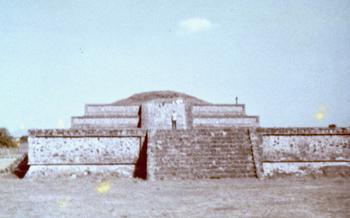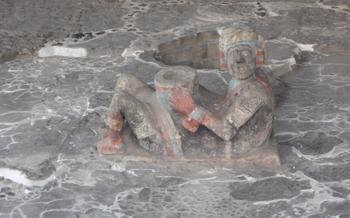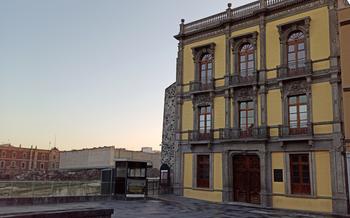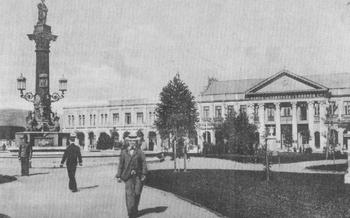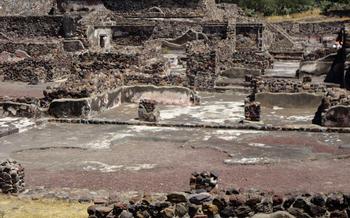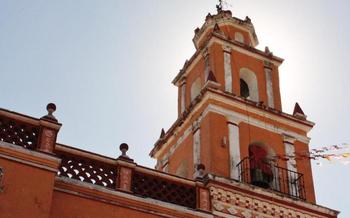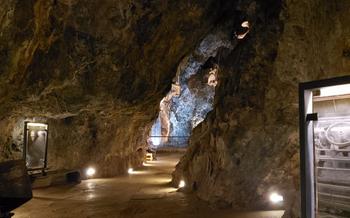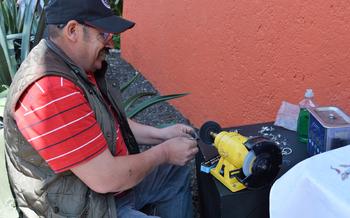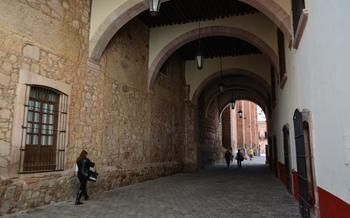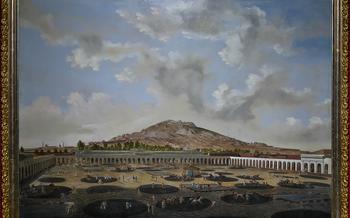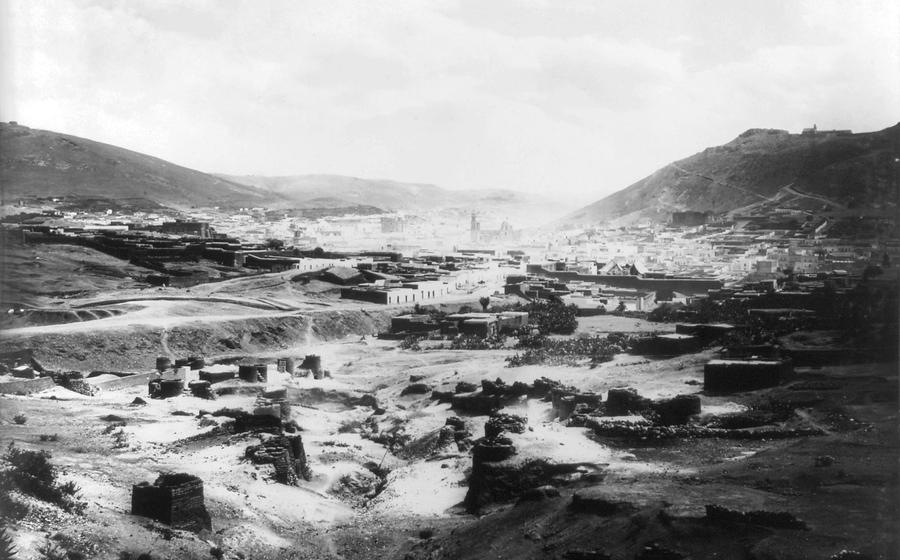
Museo Arqueológico de Zacatecas
- The Antiquity of Zacatecas
- Museo Arqueológico de Zacatecas: An Overview
- Zacatecas: Cradle of Ancient Civilizations
- Exploring the Museum's Galleries
- Ceramics and Pottery: Masterpieces of Clay
- Metalworking and Metallurgy: Shaping History
- Lithic Artifacts: Stone Tools and Craftsmanship
- Textiles and Weaving: Threads of Tradition
- Mortuary Rituals and Burials: Honoring the Dead
- Religious Expressions and Symbolism
- The Legacy of Ancient Zacatecas: Cultural Continuity
- Hours of Operation, Admission Fees, and Contact Information
- Insider Tip: Uncovering Hidden Treasures
The Antiquity of Zacatecas
Zacatecas, a city steeped in history and archaeological significance, has a rich past that dates back to the pre-Hispanic era. It was inhabited by various indigenous cultures, each leaving its mark on the region. The archaeological importance of Zacatecas lies in the discovery of numerous artifacts and relics that shed light on the lives and practices of these ancient civilizations.
The region was home to several pre-Hispanic cultures, including the Chalchihuites, who were known for their intricate stone carvings and jewelry; the Teotihuacanos, who left behind impressive architectural remains; and the Aztecs, who ruled over the area until the arrival of the Spanish in the 16th century.
The Museo Arqueológico de Zacatecas plays a crucial role in preserving and showcasing the region's archaeological heritage. Its collection includes a vast array of artifacts, such as pottery, stone tools, metal objects, and textiles, offering visitors a glimpse into the lives and customs of the ancient inhabitants of Zacatecas.
Museo Arqueológico de Zacatecas: An Overview
The Museo Arqueológico de is easily accessible and invites visitors to embark on a journey through time, exploring the diverse civilizations that once flourished in this part of Mexico.
Established in 1980 and housed in a beautifully restored 18th-century building, the museum showcases an impressive collection of archaeological artifacts unearthed from various pre-Hispanic sites throughout the state of Zacatecas. Its mission is to preserve, study, and disseminate the region's archaeological heritage, fostering a deeper understanding of the ancient cultures that shaped the history of this vibrant state.
Zacatecas: Cradle of Ancient Civilizations
Zacatecas boasts a rich history dating back to the pre-Hispanic era, serving as a cradle for several ancient civilizations. Archaeological evidence suggests the presence of early human settlements in the region as far back as 10,000 years ago. Among the major pre-Hispanic cultures that flourished in Zacatecas were the Chalchihuites, Teotihuacanos, Toltecs, and Aztecs. These civilizations left an indelible mark on the region, contributing to its cultural and historical tapestry.
Cultural exchange and interaction played a vital role in shaping the development of these pre-Hispanic societies. The Chalchihuites, known for their intricate stone carvings and turquoise jewelry, traded with distant regions, acquiring goods and ideas that influenced their culture. The Teotihuacanos, with their impressive urban planning and monumental architecture, exerted significant influence over Zacatecas, leaving behind remnants of their presence in the form of temples and artifacts. The Toltecs, renowned for their metalworking skills, introduced new techniques and designs that transformed the region's metallurgy.
The decline of pre-Hispanic civilizations in Zacatecas coincided with the arrival of the Spanish in the 16th century. The Spanish conquest brought about significant changes to the region, leading to the assimilation of indigenous cultures and the introduction of European influences. Despite these changes, the legacy of ancient Zacatecas remains deeply embedded in the region's identity, reflected in its traditions, customs, and archaeological treasures.
Exploring the Museum's Galleries
A guided tour of the Museo Arqueológico de Zacatecas is an immersive journey through time, unveiling the rich cultural heritage of the region. Each gallery showcases unique artifacts and exhibits that bring to life the stories of ancient civilizations. From intricate ceramic masterpieces to awe-inspiring metalwork, the museum's collection offers a glimpse into the lives, beliefs, and craftsmanship of the people who inhabited this land centuries ago.
The galleries are carefully organized to provide a comprehensive overview of Zacatecas's pre-Hispanic past. The chronological arrangement allows visitors to trace the evolution of cultures over time, from the early hunter-gatherer societies to the rise of complex civilizations. Interactive displays and educational resources enhance the experience, offering deeper insights into the significance of each artifact.
One of the highlights of the museum is the gallery dedicated to ceramics. Here, visitors can admire a stunning array of pottery vessels, each adorned with intricate designs and motifs. The collection showcases the remarkable artistry and technical skill of pre-Hispanic potters, who transformed clay into beautiful and functional objects.
Another must-see gallery focuses on metalworking. Zacatecas was renowned for its wealth of minerals, and the ancient inhabitants were skilled in extracting and refining metals such as copper, silver, and gold. The museum displays a variety of metal artifacts, including tools, weapons, jewelry, and ceremonial objects, showcasing the region's mastery of metallurgy.
As you wander through the galleries, take the time to examine the intricate details of each artifact. Imagine the hands that crafted these objects, the lives they lived, and the stories they could tell. The Museo Arqueológico de Zacatecas is not just a collection of ancient relics; it is a journey into the past, a celebration of the rich cultural heritage of a land that has witnessed the rise and fall of civilizations.
Ceramics and Pottery: Masterpieces of Clay
Ceramics played a crucial role in the daily lives and cultural expressions of pre-Hispanic societies in Zacatecas. Skilled artisans crafted a wide variety of ceramic objects, from utilitarian vessels for cooking and storage to finely decorated ceremonial pieces. The museum's collection boasts an impressive array of these ceramic masterpieces, showcasing the diversity of techniques and styles that flourished in the region.
One of the highlights of the collection is a stunning polychrome vessel adorned with intricate geometric patterns and stylized human figures. This piece exemplifies the artistic virtuosity of ancient Zacatecan potters, who used natural pigments to create vivid and enduring designs. Another remarkable artifact is a large incense burner, intricately sculpted with representations of deities and mythical creatures. The burner's intricate details and delicate ornamentation provide a glimpse into the religious beliefs and rituals of the region's inhabitants.
Visitors can also admire a collection of figurines, each one meticulously crafted and imbued with symbolic meaning. These figurines depict various human forms, including warriors, musicians, and deities, offering insights into the social and cultural hierarchy of pre-Hispanic Zacatecas. Through these ceramic treasures, the museum preserves and showcases the artistic legacy of ancient civilizations and allows visitors to appreciate the enduring beauty and craftsmanship of their creations.
Metalworking and Metallurgy: Shaping History
Zacatecas, a region rich in mineral resources, was a hub for metalworking and metallurgy in pre-Hispanic times. Skilled artisans employed various techniques to extract and refine metals, including copper, silver, and gold. These metals were then transformed into a diverse range of artifacts, from utilitarian tools to intricate adornments.
Copper, the most abundant metal in the region, was used to create a variety of objects, including axes, fishhooks, and needles. Silver, known for its malleability and luster, was fashioned into elaborate jewelry, ceremonial objects, and decorative items. Gold, the most prized metal, was reserved for the most significant cultural and religious artifacts, such as masks, ornaments, and votive offerings.
The metalworking techniques employed in Zacatecas were highly sophisticated. Artisans used a combination of hammering, casting, and alloying to shape and refine metals. They possessed a remarkable understanding of metallurgy, which allowed them to create objects with both aesthetic and functional qualities.
Metalworking played a crucial role in the cultural development and trade of pre-Hispanic Zacatecas. The production of metal objects facilitated economic exchanges between different regions and contributed to the development of specialized crafts. Metal artifacts were also highly valued for their symbolic and ritual significance, often used in religious ceremonies and as symbols of power and status.
Lithic Artifacts: Stone Tools and Craftsmanship
The resourceful inhabitants of ancient Zacatecas exhibited remarkable skill in crafting stone tools and weapons, utilizing techniques that transformed ordinary rocks into instruments of survival and artistry. Through a meticulous process of shaping and refining, they created arrowheads with precision points, axes for felling trees and shaping wood, and ceremonial objects imbued with symbolic significance. These lithic artifacts provide valuable insights into the technological prowess and cultural ingenuity of prehistoric societies.
The museum's collection boasts an impressive array of stone tools, each serving a distinct purpose. Arrowheads, meticulously crafted from obsidian and flint, showcase the expertise of ancient hunters who relied on these sharp projectiles for hunting and warfare. Axes, fashioned from durable materials like basalt and andesite, served as indispensable tools for felling trees, shaping wood, and performing various tasks essential for survival.
Beyond their functional significance, lithic artifacts also held symbolic and ceremonial importance. Stone sculptures and figurines, often intricately carved with human or animal motifs, were used in religious rituals and ceremonies. These artifacts offer a glimpse into the spiritual beliefs and artistic expressions of ancient Zacatecas' inhabitants.
The museum's collection of lithic artifacts stands as a testament to the ingenuity and resourcefulness of these early craftsmen. These objects, crafted with precision and imbued with both practical and symbolic value, offer a tangible connection to the rich cultural heritage of Zacatecas.
Textiles and Weaving: Threads of Tradition
Textiles, woven with intricate designs and vibrant colors, played a crucial role in the cultural fabric of pre-Hispanic Zacatecas. They served practical and symbolic purposes, adorning individuals, adorning sacred spaces, and narrating stories of identity and tradition. The Museo Arqueológico de Zacatecas showcases a remarkable collection of preserved textiles, offering a glimpse into the artistry and craftsmanship of ancient weavers.
The museum's textile exhibits showcase a breathtaking array of techniques and materials. From intricate weaving patterns to elaborate embroidery, these textiles reveal the skill and creativity of pre-Hispanic artisans. Common materials included cotton, agave fibers, and animal hair, each lending distinct textures and qualities to the finished products.
The designs and motifs found on these textiles hold profound cultural significance. Geometric patterns, stylized animals, and mythological figures adorned garments, blankets, and ceremonial cloths. These motifs served as visual languages, communicating messages about social status, religious beliefs, and ethnic identity.
Among the highlights of the museum's textile collection are beautifully preserved cloaks, tunics, and headdresses. These garments, often adorned with feathers and beads, were worn by rulers, priests, and other high-ranking members of society. The intricate designs and vibrant colors of these textiles reflect the prestige and power associated with their wearers.
Mortuary Rituals and Burials: Honoring the Dead
Archaeological excavations in Zacatecas have uncovered a wealth of evidence related to burial practices and mortuary rituals among pre-Hispanic cultures. Elaborate tombs and burial structures have been discovered, providing insights into the beliefs and customs surrounding death and the afterlife.
Tombs in Zacatecas varied greatly in size and complexity, ranging from simple pits to elaborate chambered structures. Some tombs were individual, while others were collective, containing the remains of multiple individuals. Grave goods, such as pottery vessels, jewelry, and tools, were often placed with the deceased, indicating a belief in the need for material possessions in the afterlife.
The types of grave goods included in burials varied depending on the status and wealth of the individual. Common grave goods included ceramic vessels, which may have been used for food or drink offerings, as well as personal ornaments such as beads, necklaces, and earrings. More elaborate burials might also include weapons, tools, and other objects that reflected the deceased's occupation or social status.
The discovery of burial sites in Zacatecas has provided valuable insights into the beliefs and practices surrounding death and the afterlife in pre-Hispanic societies. These burials reveal a complex and sophisticated understanding of the spiritual world, and they continue to offer important clues about the lives and beliefs of the people who inhabited this region centuries ago.
Religious Expressions and Symbolism
Religion played a central role in pre-Hispanic Zacatecas, shaping the cultural and spiritual world of its inhabitants. Ancient cultures worshipped a pantheon of deities, each associated with specific aspects of nature, fertility, and the cosmos. Among the most prominent gods were Huitzilopochtli, the god of war and the sun, and Tonatiuh, the sun god. Depictions of these deities, along with other mythological figures, can be found in various forms, including sculptures, figurines, and intricately carved objects.
Religious symbolism was deeply embedded in the art and artifacts of Zacatecas's ancient cultures. Symbolic motifs, such as the feathered serpent, the jaguar, and the eagle, held profound meanings, representing deities, celestial bodies, and natural forces. These symbols adorned ceramics, textiles, and jewelry, serving as visual representations of spiritual beliefs.
The exploration of religious expressions and symbolism in the Museo Arqueológico de Zacatecas provides a glimpse into the spiritual world of pre-Hispanic civilizations. Visitors gain insights into the beliefs, rituals, and practices that shaped the lives of ancient Zacatecans, shedding light on their profound connection to the divine.
The Legacy of Ancient Zacatecas: Cultural Continuity
The legacy of ancient Zacatecas extends far beyond its archaeological wonders. The pre-Hispanic cultures that once flourished in the region have left an enduring imprint on the cultural fabric of modern-day Zacatecas. Traditions, customs, and beliefs that have been passed down through generations continue to shape the identity of the people and the vibrant tapestry of the state.
One striking example of this cultural continuity is the widespread use of the Nahuatl language, a legacy of the powerful Aztec Empire that once dominated the region. Many communities in Zacatecas still speak Nahuatl as their native tongue, preserving a linguistic heritage that dates back centuries.
Another important aspect of Zacatecas' cultural continuity is its rich culinary tradition. Traditional dishes such as pozole, enchiladas, and tamales have their roots in pre-Hispanic cuisine, showcasing a blend of indigenous ingredients and cooking techniques. These dishes are not only delicious but also carry a deep historical significance, connecting the present with the past.
Moreover, the traditional arts and crafts of Zacatecas often draw inspiration from pre-Hispanic motifs and designs. Artisans create beautiful textiles, pottery, and jewelry that incorporate ancient symbols and patterns, paying homage to their cultural ancestors. These handcrafted items are not merely decorative but also serve as a testament to the enduring creativity and skill of the Zacatecan people.
By preserving and celebrating its rich cultural heritage, Zacatecas honors the legacy of its ancient civilizations. This cultural continuity is a source of pride for the people of Zacatecas and a reminder of the deep roots that connect them to the past. It is through this living connection that the spirit of ancient Zacatecas continues to thrive, enriching the cultural tapestry of Mexico.
Hours of Operation, Admission Fees, and Contact Information
The Museo Arqueológico de Zacatecas is open to the public from Tuesday to Sunday, from 10 am to 5 pm. Admission fees are minimal, making it an affordable attraction for visitors of all budgets. For inquiries and reservations, you can contact the museum directly by phone or email. Their friendly and knowledgeable staff will be happy to assist you with any questions you may have and provide additional information about upcoming events and exhibitions.
To plan your visit effectively, check the museum's website or social media pages for any special closures or events that may affect your schedule. Consider arriving early to avoid crowds and give yourself ample time to explore the exhibits at a leisurely pace. For visitors with disabilities, the museum is wheelchair accessible and offers designated parking spaces and accessible restrooms.
Insider Tip: Uncovering Hidden Treasures
Amidst the many captivating exhibits at the Museo Arqueológico de Zacatecas, there lies a hidden gem that often goes unnoticed by visitors. Tucked away in a corner of the lithic artifacts gallery, you'll find an unassuming display of obsidian tools. While these artifacts may seem ordinary at first glance, a closer examination reveals their extraordinary significance.
The obsidian tools in this collection are not just ordinary implements; they are masterpieces of craftsmanship and precision. The ancient artisans who created them used a unique technique called pressure flaking to shape the obsidian into intricate forms, resulting in razor-sharp blades and arrowheads. The level of detail and skill exhibited in these tools is truly remarkable.
What makes these obsidian artifacts even more special is their rarity. Obsidian is a volcanic glass that is not native to the Zacatecas region. It had to be obtained through trade or long-distance travel, making it a precious commodity. The presence of obsidian tools in this museum suggests that the ancient inhabitants of Zacatecas had connections to far-flung regions and engaged in a vibrant exchange of goods and ideas.
To truly appreciate the hidden treasures of the Museo Arqueológico de Zacatecas, take your time to explore each gallery and pay attention to the details. You may discover other hidden gems that reveal the fascinating stories of the ancient civilizations that once thrived in this region.
